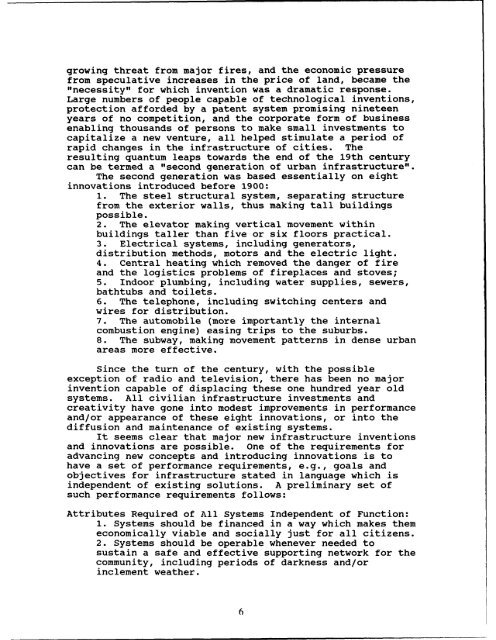Challenges and Opportunities for Innovation in the Public Works ...
Challenges and Opportunities for Innovation in the Public Works ...
Challenges and Opportunities for Innovation in the Public Works ...
You also want an ePaper? Increase the reach of your titles
YUMPU automatically turns print PDFs into web optimized ePapers that Google loves.
grow<strong>in</strong>g threat from major fires, <strong>and</strong> <strong>the</strong> economic pressure<br />
from speculative <strong>in</strong>creases <strong>in</strong> <strong>the</strong> price of l<strong>and</strong>, became <strong>the</strong><br />
"necessity" <strong>for</strong> which <strong>in</strong>vention was a dramatic response.<br />
Large numbers of people capable of technological <strong>in</strong>ventions,<br />
protection af<strong>for</strong>ded by a patent system promis<strong>in</strong>g n<strong>in</strong>eteen<br />
years of no competition, <strong>and</strong> <strong>the</strong> corporate <strong>for</strong>m of bus<strong>in</strong>ess<br />
enabl<strong>in</strong>g thous<strong>and</strong>s of persons to make small <strong>in</strong>vestments to<br />
capitalize a new venture, all helped stimulate a period of<br />
rapid changes <strong>in</strong> <strong>the</strong> <strong>in</strong>frastructure of cities. The<br />
result<strong>in</strong>g quantum leaps towards <strong>the</strong> end of <strong>the</strong> 19th century<br />
can be termed a "second generation of urban <strong>in</strong>frastructure".<br />
The second generation was based essentially on eight<br />
<strong>in</strong>novations <strong>in</strong>troduced be<strong>for</strong>e 1900:<br />
1. The steel structural system, separat<strong>in</strong>g structure<br />
from <strong>the</strong> exterior walls, thus mak<strong>in</strong>g tall build<strong>in</strong>gs<br />
possible.<br />
2. The elevator mak<strong>in</strong>g vertical movement with<strong>in</strong><br />
build<strong>in</strong>gs taller than five or six floors practical.<br />
3. Electrical systems, <strong>in</strong>clud<strong>in</strong>g generators,<br />
distribution methods, motors <strong>and</strong> <strong>the</strong> electric light.<br />
4. Central heat<strong>in</strong>g which removed <strong>the</strong> danger of fire<br />
<strong>and</strong> <strong>the</strong> logistics problems of fireplaces <strong>and</strong> stoves;<br />
5. Indoor plumb<strong>in</strong>g, <strong>in</strong>clud<strong>in</strong>g water supplies, sewers,<br />
bathtubs <strong>and</strong> toilets.<br />
6. The telephone, <strong>in</strong>clud<strong>in</strong>g switch<strong>in</strong>g centers <strong>and</strong><br />
wires <strong>for</strong> distribution.<br />
7. The automobile (more importantly <strong>the</strong> <strong>in</strong>ternal<br />
combustion eng<strong>in</strong>e) eas<strong>in</strong>g trips to <strong>the</strong> suburbs.<br />
8. The subway, mak<strong>in</strong>g movement patterns <strong>in</strong> dense urban<br />
areas more effective.<br />
S<strong>in</strong>ce <strong>the</strong> turn of <strong>the</strong> century, with <strong>the</strong> possible<br />
exception of radio <strong>and</strong> television, <strong>the</strong>re has been no major<br />
<strong>in</strong>vention capable of displac<strong>in</strong>g <strong>the</strong>se one hundred year old<br />
systems. All civilian <strong>in</strong>frastructure <strong>in</strong>vestments <strong>and</strong><br />
creativity have gone <strong>in</strong>to modest improvements <strong>in</strong> per<strong>for</strong>mance<br />
<strong>and</strong>/or appearance of <strong>the</strong>se eight <strong>in</strong>novations, or <strong>in</strong>to <strong>the</strong><br />
diffusion <strong>and</strong> ma<strong>in</strong>tenance of exist<strong>in</strong>g systems.<br />
It seems clear that major new <strong>in</strong>frastructure <strong>in</strong>ventions<br />
<strong>and</strong> <strong>in</strong>novations are possible. One of <strong>the</strong> requirements <strong>for</strong><br />
advanc<strong>in</strong>g new concepts <strong>and</strong> <strong>in</strong>troduc<strong>in</strong>g <strong>in</strong>novations is to<br />
have a set of per<strong>for</strong>mance requirements, e.g., goals <strong>and</strong><br />
objectives <strong>for</strong> <strong>in</strong>frastructure stated <strong>in</strong> language which is<br />
<strong>in</strong>dependent of exist<strong>in</strong>g solutions. A prelim<strong>in</strong>ary set of<br />
such per<strong>for</strong>mance requirements follows:<br />
Attributes Required of All Systems Independent of Function:<br />
1. Systems should be f<strong>in</strong>anced <strong>in</strong> a way which makes <strong>the</strong>m<br />
economically viable <strong>and</strong> socially just <strong>for</strong> all citizens.<br />
2. Systems should be operable whenever needed to<br />
susta<strong>in</strong> a safe <strong>and</strong> effective support<strong>in</strong>g network <strong>for</strong> <strong>the</strong><br />
community, <strong>in</strong>clud<strong>in</strong>g periods of darkness <strong>and</strong>/or<br />
<strong>in</strong>clement wea<strong>the</strong>r.<br />
6







